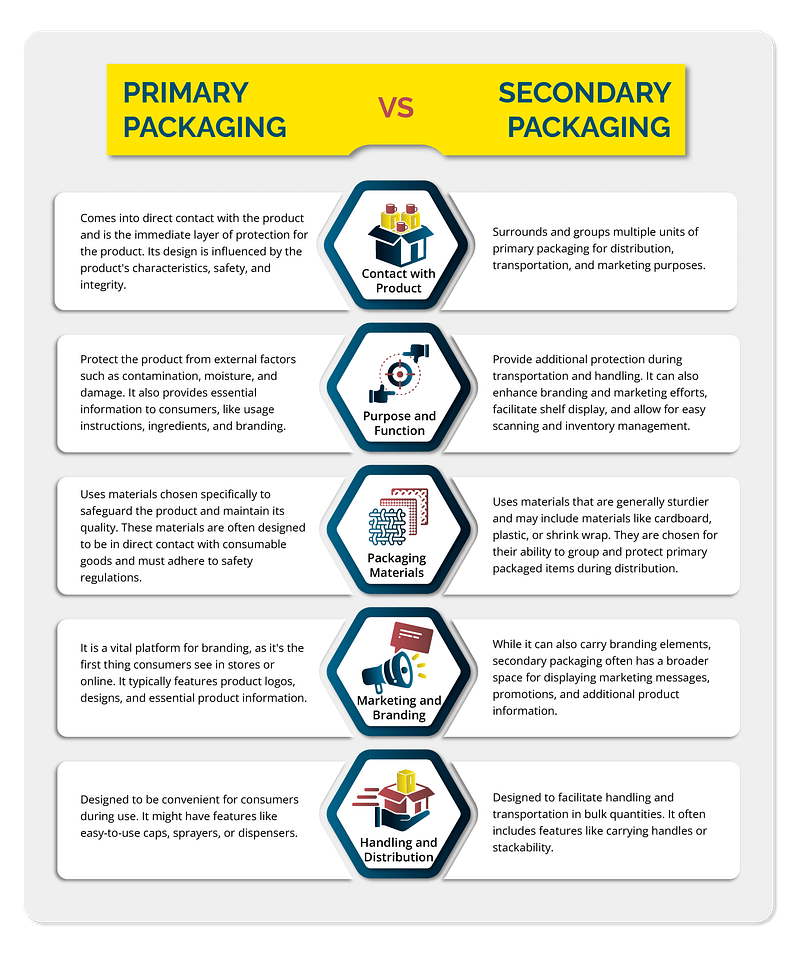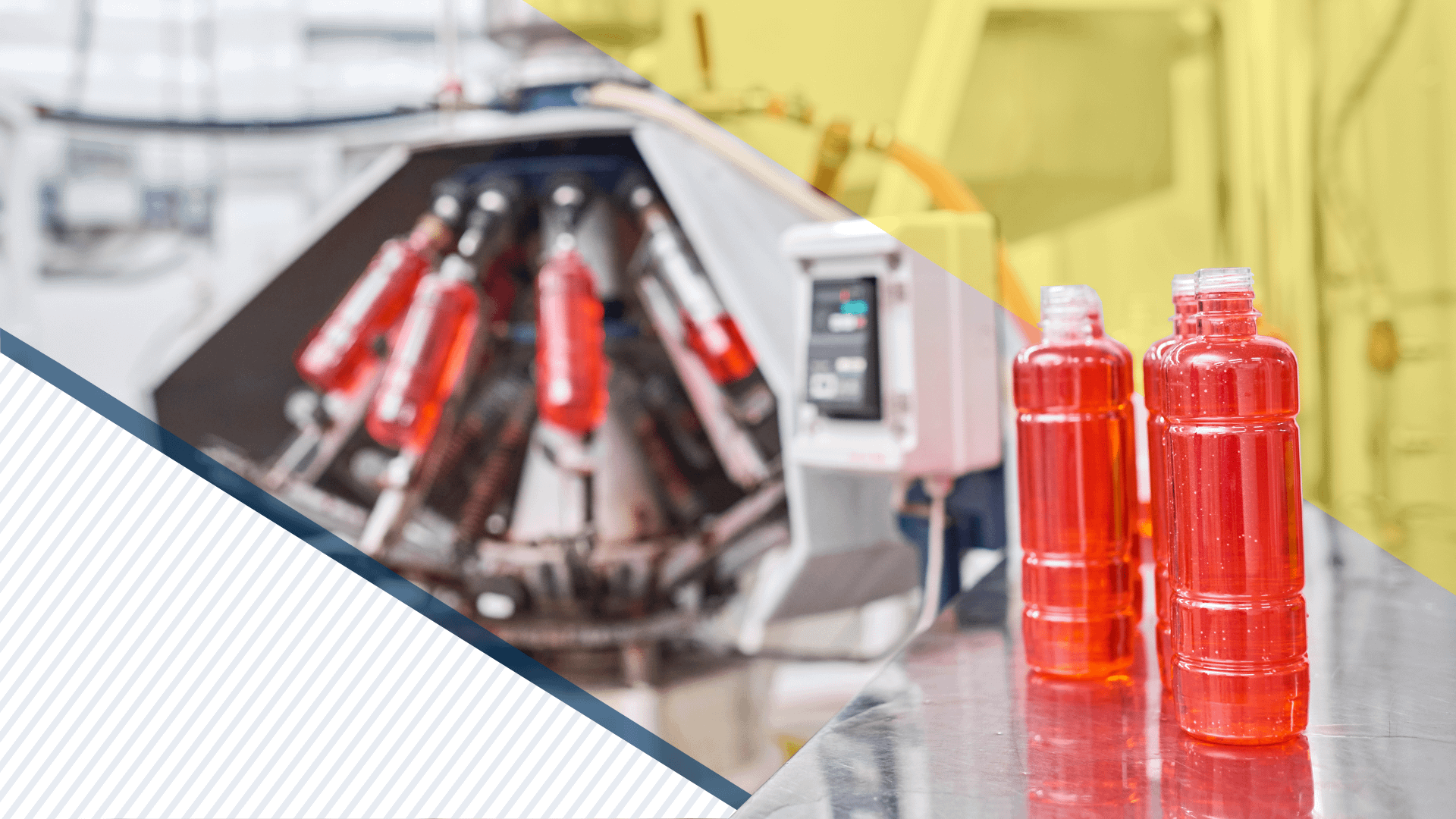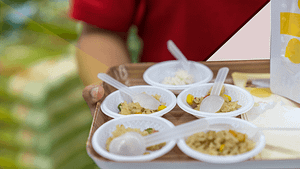When it comes to product appearance and protection, packaging is of utmost importance. Packaging is used for nearly every consumer product, however, not all packaging types are the same. In this article, we will focus on the two main distinct packaging types: primary and secondary– and explore their impact on consumer experience.
Primary vs Secondary Packaging
Primary packaging and secondary packaging are two distinct layers of packaging used in the product distribution and retail process. Both packaging types serve a specific purpose within the business’s supply chain strategy in protecting products, enhancing their visual appeal, and providing important information to consumers. Here is a breakdown of these two types of packaging:
What Is Primary Packaging?
Primary packaging is the first layer of packaging that comes into direct contact with the product. Think of your favorite snack or drink, more than likely, it’s only protected by one layer of packaging. This would be the primary packaging for that product and it’s the first layer of protection from external factors such as moisture, light, air, and contamination. Other functions may include:
- Product Protection: Primary packaging serves as the primary barrier between the product and the external environment. It prevents physical damage, contamination, and deterioration, ensuring the product’s quality and safety.
- Presentation: Primary packaging plays a pivotal role in product presentation and brand identity. It is often designed to enhance the product’s visual appeal, communicate essential information, and create a recognizable brand image.
- Dispensing and Usage: Primary packaging is designed to facilitate easy dispensing and usage of the product. This is particularly important for products that are used or consumed over time.
Primary packaging comes in many different shapes and sizes depending on the products composition. These packaging vessels include:
- Bottles and Jars: These are commonly used for liquids, powders, creams, and other substances. They often come with lids, caps, or closures to seal the product.
- Blister Packs: These are commonly used for pharmaceuticals and small consumer goods. They consist of a plastic cavity that holds the product and a backing (usually made of foil or plastic) that keeps the product secure.
- Cans and Tins: These are used for products like beverages, food, and chemicals. They provide a protective barrier and are often sealed to prevent tampering.
- Pouches and Sachets: These are flexible packaging options often used for single servings of products, such as condiments, snacks, and cosmetic samples.
- Ampoules and Vials: Common in the pharmaceutical and medical industries, these small, sealed containers hold a single dose of medication or other substances.
- Cartons and Boxes: While these might seem more like secondary packaging, they can also be considered primary packaging if the product is directly stored and displayed in them, such as with cereal boxes or cosmetic sets.
- Tube Packaging: Commonly used for products like toothpaste, creams, and gels. Tubes are easy to use and allow controlled dispensing of the product.
- Vials and Bottles with Dropper Caps: Often used for liquid products like essential oils, medications, and cosmetics, these allow controlled dispensing drop by drop.
What Is Secondary Packaging?
Secondary packaging is the outer layer of packaging that surrounds the primary packaging. For example, if you’ve ever purchased a pack of canned dog food, chances are it comes in a multi-pack that has these cans shrink-wrapped to a corrugated tray, this is a great example of secondary packaging in action. Although it doesn’t ever come into direct contact with the product, secondary packaging is crucial to ensure products are secure and safe throughout the distribution process. It’s also beneficial for:
- Branding and Information: Secondary packaging offers a larger surface area for branding, product information, regulatory labeling, and other essential details that may not fit on the primary packaging.
- Facilitates Handling: Secondary packaging makes it easier to handle, stack, and transport multiple units of the product. It helps streamline logistics and distribution processes.
- Retail Display: Secondary packaging is often designed to enhance shelf presence and catch the consumer’s attention. It can include features like display windows or handles for easy carrying.
Examples of secondary packaging include:
- Cardboard Boxes: These are commonly used to contain multiple units of a product. They provide a protective layer around primary packaged items and often feature branding, product information, and barcodes for easy scanning.
- Shrink Wrap: A plastic film is heat-shrunk around a group of primary packaged items, holding them together securely while providing a clear view of the products. This is commonly seen on packages of bottled water or canned beverages.
- Outer Wraps: Printed paper or plastic wraps that enclose several primary packaged items. They offer protection and allow for branding and labeling.
- Cartons: Larger cartons that hold multiple primary packaged products, often used for bulk purchases. These are commonly seen in warehouse stores.
- Multipacks: Packaging that contains multiple individual units of a product, usually grouped together for promotional or convenience purposes. Examples include multi-pack snacks or toiletries.
- Retail Ready Packaging (RRP): Packaging designed for easy display in retail environments, reducing the need for unpacking before placing products on shelves. This can include shelf-ready trays or boxes.
What Are The Differences Between Primary and Secondary Packaging?
Primary packaging and secondary packaging serve distinct purposes within the packaging hierarchy. Here are the key differences between the two:
Direct Contact with Product
Primary Packaging: Comes into direct contact with the product and is the immediate layer of protection for the product. Its design is influenced by the product’s characteristics, safety, and integrity.
Secondary Packaging: Surrounds and groups multiple units of primary packaging for distribution, transportation, and marketing purposes.
Purpose and Function
Primary Packaging: Protect the product from external factors such as contamination, moisture, and damage. It also provides essential information to consumers, like usage instructions, ingredients, and branding.
Secondary Packaging: Provide additional protection during transportation and handling. It can also enhance branding and marketing efforts, facilitate shelf display, and allow for easy scanning and inventory management.
Packaging Materials
Primary Packaging: Uses materials chosen specifically to safeguard the product and maintain its quality. These materials are often designed to be in direct contact with consumable goods and must adhere to safety regulations.
Secondary Packaging: Uses materials that are generally sturdier and may include materials like cardboard, plastic, or shrink wrap. They are chosen for their ability to group and protect primary packaged items during distribution.
Marketing and Branding
Primary Packaging: It is a vital platform for branding, as it’s the first thing consumers see in stores or online. It typically features product logos, designs, and essential product information.
Secondary Packaging: While it can also carry branding elements, secondary packaging often has a broader space for displaying marketing messages, promotions, and additional product information
Handling and Distribution
Primary Packaging: Designed to be convenient for consumers during use. It might have features like easy-to-use caps, sprayers, or dispensers.
Secondary Packaging: Designed to facilitate handling and transportation in bulk quantities. It often includes features like carrying handles or stackability.

What is Tertiary Packaging?
Tertiary packaging refers to the packaging used for the bulk handling, storage, and transportation of multiple units of secondary packaged items. Its primary purpose is to protect the products during long-distance transit, storage, and distribution within the supply chain. Tertiary packaging is not typically meant to be opened by consumers; rather, it is often removed at the distribution center or retail store.
Examples of tertiary packaging include:
Pallets: Stacked platform structures that hold multiple units of secondary packaging, making it easier to move products using forklifts or pallet jacks.
Stretch Wrap or Shrink Wrap: Used to secure and stabilize boxes on pallets, preventing them from shifting during transportation.
Corrugated Cardboard Boxes: Large, durable boxes used to contain multiple units of secondary packaging on a pallet.
Work With Nautical – Your New Full Service Packaging Partner
Understanding the different packaging types is essential to protecting your goods and ensuring consumers always see the best of your product. However, you don’t have to do it alone. Working with a reliable partner in the packaging space can help alleviate stress and allow you to focus on other business operations.
Working with Nautical is a great option for any business looking for a full-service packaging solution for their products. We understand all the different ways products can be potentially damaged, from warehouse — to a store shelf, that’s why we focus on providing expert packaging solutions in addition to being a vertically integrated supply chain company for all other logistics needs.




